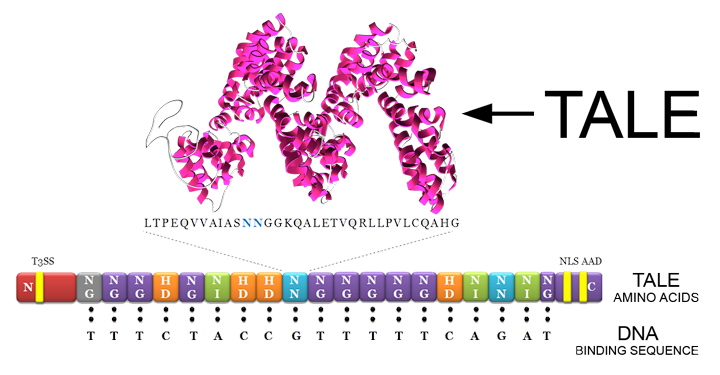Part:BBa_K1189005
TALEB Target ([B])
To test the function of the TALE B, we had to synthesize the target sequences that they would recognize and bind with. We constructed a series of target sequences that directly corresponded with the TALE protein sequence to test the binding affinity.
Transcriptor Activator-Like Effectors (TALEs) are proteins produced by bacteria of the genus Xanthomonas and secreted into plant cells. These naturally occurring TALEs play a key role in bacterial infection, as they are responsible for up regulation of the host genes required for pathogenic growth and expansion (Mussolino and Cathomen, 2012). These special bacterial plant pathogen proteins bind to DNA by specifically recognizing one base pair with a single tandem repeat in their DNA-binding domain. TALEs are an advantageous tool in synthetic biology because they can be modified to bind to a chosen DNA sequence. The central region of the protein, also termed repeat region, mediates DNA recognition through tandem repeats of 33 to 35 amino acids residues each (Bogdanove et al., 2010). The binding domain usually comprises 15.5 to 19.5 single repeats. The last repeat, close to the C-terminus, is called “half-repeat” because it is only approximately 20 amino acids in length. Although the modules have conserved sequences, polymorphisms are found in residues 12 and 13, the “repeat-variable di-residue” (RVD). RVDs are specific for a single nucleotide; therefore, 19.5 repeat units target a specific 20-nucleotide sequence in the DNA (Mussolino and Cathomen, 2012).
TALE A was originally designed by Slovenia's 2012 iGEM team (BBa_K782004). However, Slovenia's team made the part for use in eukaryotic cells. We modified the part so that it can be used in E. coli by removing the Kozak sequence and nuclear localization sequence, and codon optimizing it for E. coli.
Sequence and Features
- 10COMPATIBLE WITH RFC[10]
- 12COMPATIBLE WITH RFC[12]
- 21COMPATIBLE WITH RFC[21]
- 23COMPATIBLE WITH RFC[23]
- 25INCOMPATIBLE WITH RFC[25]Illegal AgeI site found at 213
Illegal AgeI site found at 325 - 1000COMPATIBLE WITH RFC[1000]
| None |

